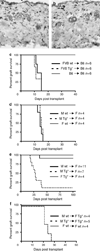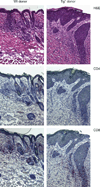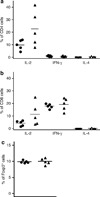Langerhans cells are not required for efficient skin graft rejection
- PMID: 18337832
- PMCID: PMC3668350
- DOI: 10.1038/jid.2008.52
Langerhans cells are not required for efficient skin graft rejection
Abstract
The mechanism of skin allograft rejection has been thought to require presentation of graft antigen by resident epidermal Langerhans cells (LCs). We have previously engineered mice that have a selective and constitutive absence of epidermal LCs. By using donor skin from these LC-deficient mice, we show that LCs are not required for rejection of major (FVB --> B6) or minor (H-Y, male --> female on B6 background) antigen-mismatched skin grafts. On the FVB background, where H-Y mismatched grafts are normally maintained indefinitely, grafts lacking LCs are efficiently rejected. Thus, LCs in the donor graft are required for long-term skin engraftment, which supports a regulatory role for LCs in skin graft acceptance.
Conflict of interest statement
The authors state no conflict of interest.
Figures



Comment in
-
A paradigm shift in the mechanisms of graft rejection.J Invest Dermatol. 2008 Aug;128(8):1874. doi: 10.1038/jid.2008.173. J Invest Dermatol. 2008. PMID: 18626477 No abstract available.
-
Langerhans cell dogma: another round of rejections.J Invest Dermatol. 2008 Aug;128(8):1881-3. doi: 10.1038/jid.2008.167. J Invest Dermatol. 2008. PMID: 18626480
References
-
- Banchereau J, Briere F, Caux C, Davoust J, Lebecque S, Liu YJ, et al. Immunobiology of dendritic cells. Annu Rev Immunol. 2000;18:767–811. - PubMed
-
- Benichou G, Valujskikh A, Heeger PS. Contributions of direct and indirect T cell alloreactivity during allograft rejection in mice. J Immunol. 1999;162:352–358. - PubMed
Publication types
MeSH terms
Substances
Grants and funding
LinkOut - more resources
Full Text Sources
Other Literature Sources
Molecular Biology Databases

